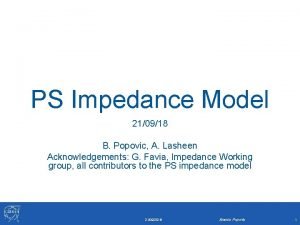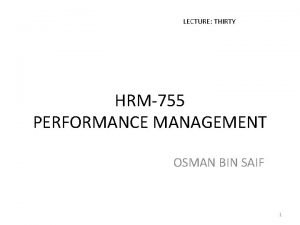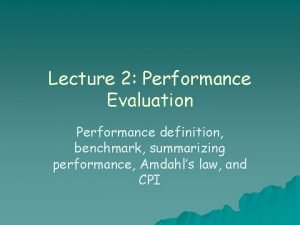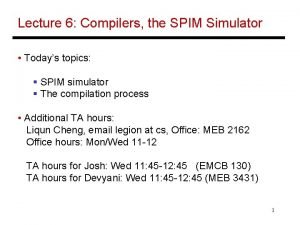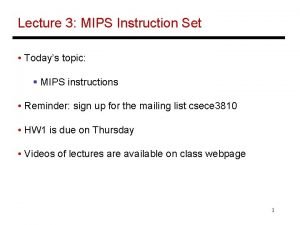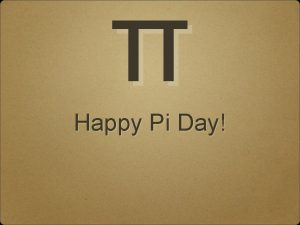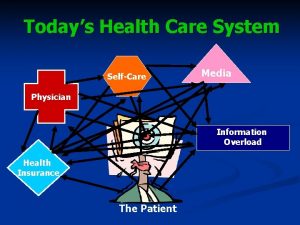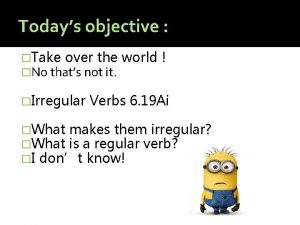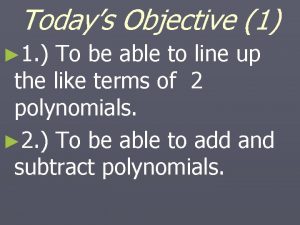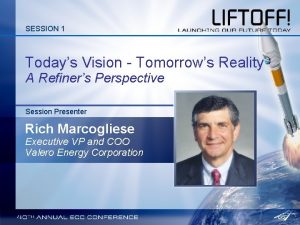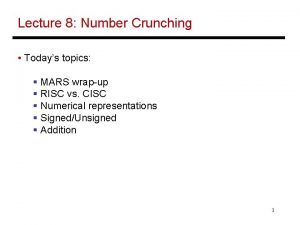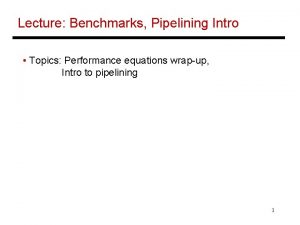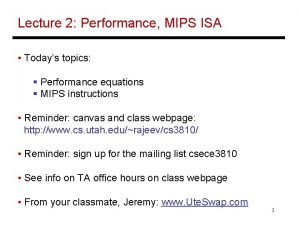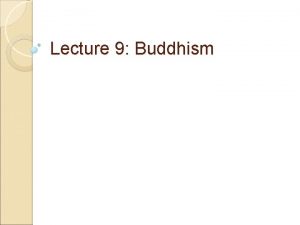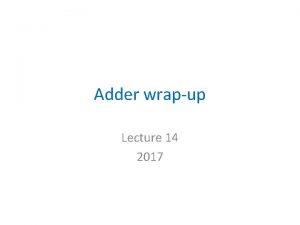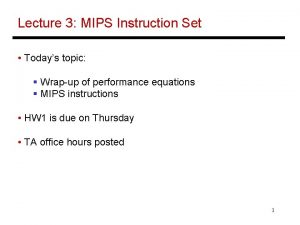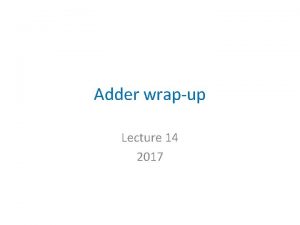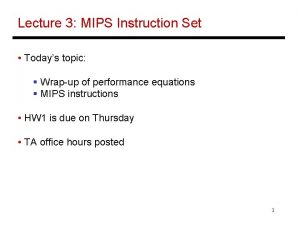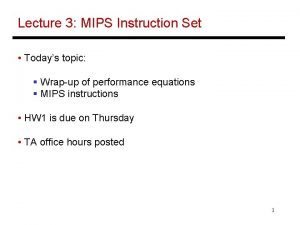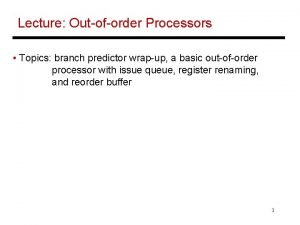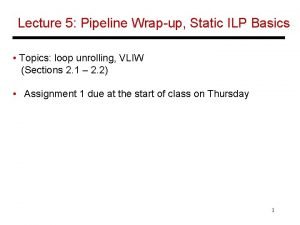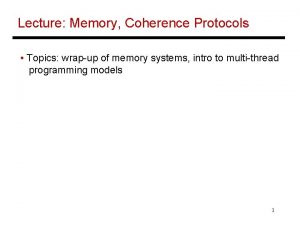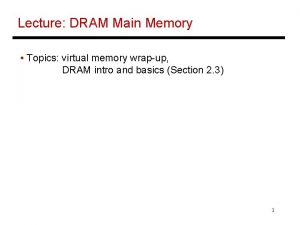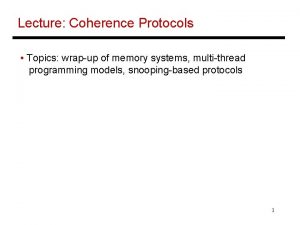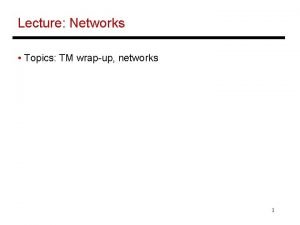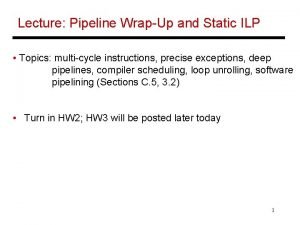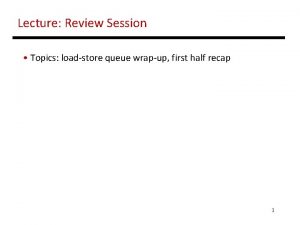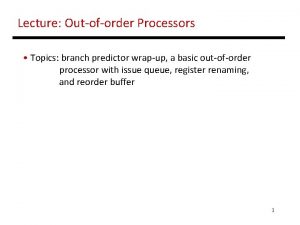Lecture 2 Performance Todays topics Technology wrapup Performance





![The HW/SW Interface Application software a[i] = b[i] + c; Compiler Systems software (OS, The HW/SW Interface Application software a[i] = b[i] + c; Compiler Systems software (OS,](https://slidetodoc.com/presentation_image_h/13147d6239fad7d89335e4acf3509c37/image-6.jpg)
















- Slides: 22

Lecture 2: Performance • Today’s topics: § Technology wrap-up § Performance trends and equations • Reminders: You. Tube videos, canvas, and class webpage: http: //www. cs. utah. edu/~rajeev/cs 3810/ • Apply to be a CS tutor: https: //www. cs. utah. edu/tutor-app/ 1

Important Trends • Running out of ideas to improve single thread performance • Power wall makes it harder to add complex features • Power wall makes it harder to increase frequency • Additional performance provided by: more cores, occasional spikes in frequency, accelerators 2

Important Trends • Historical contributions to performance: 1. Better processes (faster devices) ~20% 2. Better circuits/pipelines ~15% 3. Better organization/architecture ~15% In the future, bullet-2 will help little and bullet-1 will eventually disappear! Pentium P-Pro P-III P-4 Itanium Montecito Year 1993 95 97 99 2000 2002 2005 Transistors 3. 1 M 5. 5 M 7. 5 M 9. 5 M 42 M 300 M 1720 M Clock Speed 60 M 200 M 300 M 500 M 1500 M 800 M 1800 M Moore’s Law in action At this point, adding transistors to a core yields little benefit 3

What Does This Mean to a Programmer? • Today, one can expect only a 20% annual improvement; the improvement is even lower if the program is not multi-threaded § A program needs many threads § The threads need efficient synchronization and communication § Data placement in the memory hierarchy is important § Accelerators should be used when possible 4

Challenges for Hardware Designers • Find efficient ways to § improve single-thread performance and energy § improve data sharing § boost programmer productivity § manage the memory system § build accelerators for important kernels § provide security 5
![The HWSW Interface Application software ai bi c Compiler Systems software OS The HW/SW Interface Application software a[i] = b[i] + c; Compiler Systems software (OS,](https://slidetodoc.com/presentation_image_h/13147d6239fad7d89335e4acf3509c37/image-6.jpg)
The HW/SW Interface Application software a[i] = b[i] + c; Compiler Systems software (OS, compiler) lw add lw lw add sw $15, 0($2) $16, $15, $14 $17, $15, $13 $18, 0($12) $19, 0($17) $20, $18, $19 $20, 0($16) Assembler Hardware 000000101100000 11010000010 … 6

Computer Components • Input/output devices • Secondary storage: non-volatile, slower, cheaper (HDD/SSD) • Primary storage: volatile, faster, costlier (RAM) • CPU/processor (datapath and control) 7

Wafers and Dies Source: H&P Textbook 8

Manufacturing Process • Silicon wafers undergo many processing steps so that different parts of the wafer behave as insulators, conductors, and transistors (switches) • Multiple metal layers on the silicon enable connections between transistors • The wafer is chopped into many dies – the size of the die determines yield and cost 9

Processor Technology Trends • Shrinking of transistor sizes: 250 nm (1997) 130 nm (2002) 70 nm (2008) 35 nm (2014) 2019, start of transition from 14 nm to 10 nm • Transistor density increases by 35% per year and die size increases by 10 -20% per year… functionality improvements! • Transistor speed improves linearly with size (complex equation involving voltages, resistances, capacitances) • Wire delays do not scale down at the same rate as transistor delays 10

Memory and I/O Technology Trends • DRAM density increases by 40 -60% per year, latency has reduced by 33% in 10 years (the memory wall!), bandwidth improves twice as fast as latency decreases • Disk density improves by 100% every year, latency improvement similar to DRAM • Networks: primary focus on bandwidth; 10 Mb 100 Mb in 10 years; 100 Mb 1 Gb in 5 years 11

Performance Metrics • Possible measures: § response time – time elapsed between start and end of a program § throughput – amount of work done in a fixed time • The two measures are usually linked § A faster processor will improve both § More processors will likely only improve throughput § Some policies will improve throughput and worsen response time • What influences performance? 12

Execution Time Consider a system X executing a fixed workload W Performance. X = 1 / Execution time. X Execution time = response time = wall clock time - Note that this includes time to execute the workload as well as time spent by the operating system co-ordinating various events The UNIX “time” command breaks up the wall clock time as user and system time 13

Speedup and Improvement • System X executes a program in 10 seconds, system Y executes the same program in 15 seconds • System X is 1. 5 times faster than system Y • The speedup of system X over system Y is 1. 5 (the ratio) = perf X / perf Y = exectime Y / exectime X • The performance improvement of X over Y is 1. 5 -1 = 0. 5 = 50% = (perf X – perf Y) / perf Y = speedup - 1 • The execution time reduction for system X, compared to Y is (15 -10) / 15 = 33% 14 The execution time increase for Y, compared to X is (15 -10) / 10 = 50%

A Primer on Clocks and Cycles 15

Performance Equation - I CPU execution time = CPU clock cycles x Clock cycle time = 1 / Clock speed If a processor has a frequency of 3 GHz, the clock ticks 3 billion times in a second – as we’ll soon see, with each clock tick, one or more/less instructions may complete If a program runs for 10 seconds on a 3 GHz processor, how many clock cycles did it run for? If a program runs for 2 billion clock cycles on a 1. 5 GHz processor, what is the execution time in seconds? 16

Performance Equation - II CPU clock cycles = number of instrs x avg clock cycles per instruction (CPI) Substituting in previous equation, Execution time = clock cycle time x number of instrs x avg CPI If a 2 GHz processor graduates an instruction every third cycle, how many instructions are there in a program that runs for 10 seconds? 17

Factors Influencing Performance Execution time = clock cycle time x number of instrs x avg CPI • Clock cycle time: manufacturing process (how fast is each transistor), how much work gets done in each pipeline stage (more on this later) • Number of instrs: the quality of the compiler and the instruction set architecture • CPI: the nature of each instruction and the quality of the architecture implementation 18

Example Execution time = clock cycle time x number of instrs x avg CPI Which of the following two systems is better? • A program is converted into 4 billion MIPS instructions by a compiler ; the MIPS processor is implemented such that each instruction completes in an average of 1. 5 cycles and the clock speed is 1 GHz • The same program is converted into 2 billion x 86 instructions; the x 86 processor is implemented such that each instruction completes in an average of 6 cycles and the clock speed is 1. 5 GHz 19

Power and Energy • Total power = dynamic power + leakage power • Dynamic power a activity x capacitance x voltage 2 x frequency • Leakage power a voltage • Energy = power x time (joules) (watts) (sec) 20

Example Problem • A 1 GHz processor takes 100 seconds to execute a program, while consuming 70 W of dynamic power and 30 W of leakage power. Does the program consume less energy in Turbo boost mode when the frequency is increased to 1. 2 GHz? 21

Example Problem • A 1 GHz processor takes 100 seconds to execute a program, while consuming 70 W of dynamic power and 30 W of leakage power. Does the program consume less energy in Turbo boost mode when the frequency is increased to 1. 2 GHz? Normal mode energy = 100 W x 100 s = 10, 000 J Turbo mode energy = (70 x 1. 2 + 30) x 100/1. 2 = 9, 500 J Note: Frequency only impacts dynamic power, not leakage power. We assume that the program’s CPI is unchanged when frequency is changed, i. e. , exec time varies linearly 22 with cycle time.
 @t.kfa:wrapup.playstation.com
@t.kfa:wrapup.playstation.com 01:640:244 lecture notes - lecture 15: plat, idah, farad
01:640:244 lecture notes - lecture 15: plat, idah, farad Technology research topics
Technology research topics Performance management lecture
Performance management lecture Wbb99
Wbb99 Generations
Generations Today's class answers
Today's class answers Multiple choice comma quiz
Multiple choice comma quiz Todays worldld
Todays worldld Define radient energy
Define radient energy Todays globl
Todays globl Todays wordlw
Todays wordlw Chapter 13 marketing in today's world
Chapter 13 marketing in today's world Todays plan
Todays plan Todays sabbath lesson
Todays sabbath lesson Todays sabbath school lesson
Todays sabbath school lesson Todays match
Todays match Todays health
Todays health How to identify simile
How to identify simile Todays objective
Todays objective Today's objective
Today's objective Todays whether
Todays whether Todays vision
Todays vision
